Companion Animal Management Exam 1
0.0(0)
0.0(0)
Card Sorting
1/137
There's no tags or description
Looks like no tags are added yet.
Study Analytics
Name | Mastery | Learn | Test | Matching | Spaced |
|---|
No study sessions yet.
138 Terms
1
New cards
3 Key Features of Companion Animals
1.) Partially or totally dependent on humans
2.) Live in close proximity to us
3.) Have a special association with people (bond)
- reciprocal dynamic interaction between animals and owner result in
true relationship
2.) Live in close proximity to us
3.) Have a special association with people (bond)
- reciprocal dynamic interaction between animals and owner result in
true relationship
2
New cards
Companion
Com - with
Pan - panis - bread
Companion = break bread with
- we share our food with these animals and receive companionship in
return
Pan - panis - bread
Companion = break bread with
- we share our food with these animals and receive companionship in
return
3
New cards
Companion Animal meaning
more recent term, signals changed role of animals in society
4
New cards
What are some benefits and obligations of ownership?
Benefits: we create a bond with the animal, which can help to ease anxiety, etc.
Obligations: Taking care of your pet/animals, meaning you have to keep an eye on how they're doing, feed them, etc.
Obligations: Taking care of your pet/animals, meaning you have to keep an eye on how they're doing, feed them, etc.
5
New cards
___% of U.S households own at least one pet = ____ million homes
68%, 84.6
6
New cards
___% of current pet-owning households have multiple types of pets
46%
7
New cards
How many U.S. households?
How many pets?
How many pets?
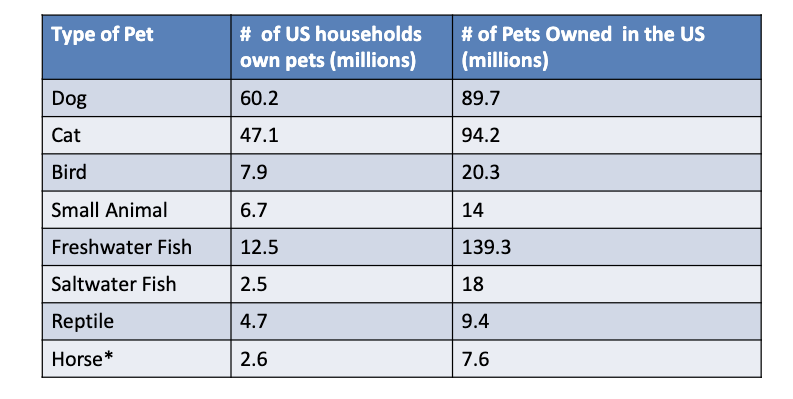
8
New cards
The companion animal industry in the U.S. is worth __________ dollars?
About $70 billion
9
New cards
In 2017, we spent $____ on pets in the U.S.
69.36 billion
10
New cards
Companion Animal Industry money breakdown
In 2017, we spent $69.36 billion on pets in the U.S.
• Food $29.69 billion
• Supplies/OTC Medicine $14.93 billion
• Vet Care $16.62 billion
• Live animal purchases $2.10 billion
• Pet Services: grooming & boarding $6.11 billion
• Food $29.69 billion
• Supplies/OTC Medicine $14.93 billion
• Vet Care $16.62 billion
• Live animal purchases $2.10 billion
• Pet Services: grooming & boarding $6.11 billion
11
New cards
What is the most common type of pet in US households?
Dogs are the most common in households at 60.2 million.
12
New cards
How much is the US companion animal industry worth now?
It is projected that people in the USA will spend close to $109.6 billion in 2022
13
New cards
What types of companions are part of the companion animal industry?
Dogs, cats, fish, bird, reptiles, other small animals (guinea pigs, hamsters, rabbits, etc)
14
New cards
How does the ‘humanization’ of animals play a role in the size of the industry?
As animals get more humanized, the more money we're willing to spend on them. For things like clothing, better food, vet care, etc.
• Companion animals provide an outlet for expressions of emotion and caregiving
– We think of animals with sentiment and affection
– We show them compassion, and empathy—and feel they give us the same without judgment
– We miss them and grieve for them
– We care for them on a daily basis
• Owning companion animals also encourages us to socialize with other people
– Walking with a dog (or baby) results in more interactions with other people than walking alone
– We must go to pet stores, vet clinics, training classes, etc a result of our pets
• Companion animals provide an outlet for expressions of emotion and caregiving
– We think of animals with sentiment and affection
– We show them compassion, and empathy—and feel they give us the same without judgment
– We miss them and grieve for them
– We care for them on a daily basis
• Owning companion animals also encourages us to socialize with other people
– Walking with a dog (or baby) results in more interactions with other people than walking alone
– We must go to pet stores, vet clinics, training classes, etc a result of our pets
15
New cards
Why is the companion animal industry so big and keeps growing?
1- Lots of pets = lots of food and supplies to meet basic needs, including health care
2- As the overall economy improves, people have more money to spend on extras
3- Humanization of animals results in spending more money on them (Companion animals are more integrated into the family (no longer just outside dogs or barn cats)
4- Premiumization = more and more high-end, specialty products
5- Recognition of health benefits that having a companion animal brings to humans
6- Human Demographics
2- As the overall economy improves, people have more money to spend on extras
3- Humanization of animals results in spending more money on them (Companion animals are more integrated into the family (no longer just outside dogs or barn cats)
4- Premiumization = more and more high-end, specialty products
5- Recognition of health benefits that having a companion animal brings to humans
6- Human Demographics
16
New cards
What generations play a big role in driving the companion animal industry? (Will the industry continue to grow?)
1. Baby Boomers
–Spend lots on pets once
human kids leave home
–Spending often declines at ~55 years old, but BB
spending on pets is peaking between 55-64
–Boomers were the largest segment of pet owners
(37%) till 2015 (>health : < supplies)
2. Millennials (Gen Y- Echo-boomer)
• The generation of people born during the 1980s
and early 1990s.
• First generation to grow up thinking of pets more
like humans than animals
– Largest generation in the U.S. AND the largest pet
owner demographic
– Starting to have their own disposable income—and
many are using to buy and pamper pets
• Spent $11 billion on your pets in 2014
• Are more willing to spend money on premium (higher
priced) products and services
• iGen = born in 1996 or later
–Just beginning to enter the work force or have
independence in college
–Not as much disposable income (yet)
- Believed that they will be the largest ones in the next few years
–Spend lots on pets once
human kids leave home
–Spending often declines at ~55 years old, but BB
spending on pets is peaking between 55-64
–Boomers were the largest segment of pet owners
(37%) till 2015 (>health : < supplies)
2. Millennials (Gen Y- Echo-boomer)
• The generation of people born during the 1980s
and early 1990s.
• First generation to grow up thinking of pets more
like humans than animals
– Largest generation in the U.S. AND the largest pet
owner demographic
– Starting to have their own disposable income—and
many are using to buy and pamper pets
• Spent $11 billion on your pets in 2014
• Are more willing to spend money on premium (higher
priced) products and services
• iGen = born in 1996 or later
–Just beginning to enter the work force or have
independence in college
–Not as much disposable income (yet)
- Believed that they will be the largest ones in the next few years
17
New cards
What is the other demographic group in the U.S. that spends a lot of money on their pets?
Millennials
18
New cards
Why Taxonomy is important?
1- It helps Biologists to identify the millions of species that
are on the planet.
▪ Every species is belonging to a certain group; once this group is
recognized, this species will be named, fully described, and officially
registered in the Catalogue of Life.
2- It clears up any kind of confusion in naming practices of
organisms, and keep things simpler for scientists.
3- It helps to group organisms and connect them to each other which facilitates studying or conducting research on them.
are on the planet.
▪ Every species is belonging to a certain group; once this group is
recognized, this species will be named, fully described, and officially
registered in the Catalogue of Life.
2- It clears up any kind of confusion in naming practices of
organisms, and keep things simpler for scientists.
3- It helps to group organisms and connect them to each other which facilitates studying or conducting research on them.
19
New cards
Bases of classification; Cellular Level
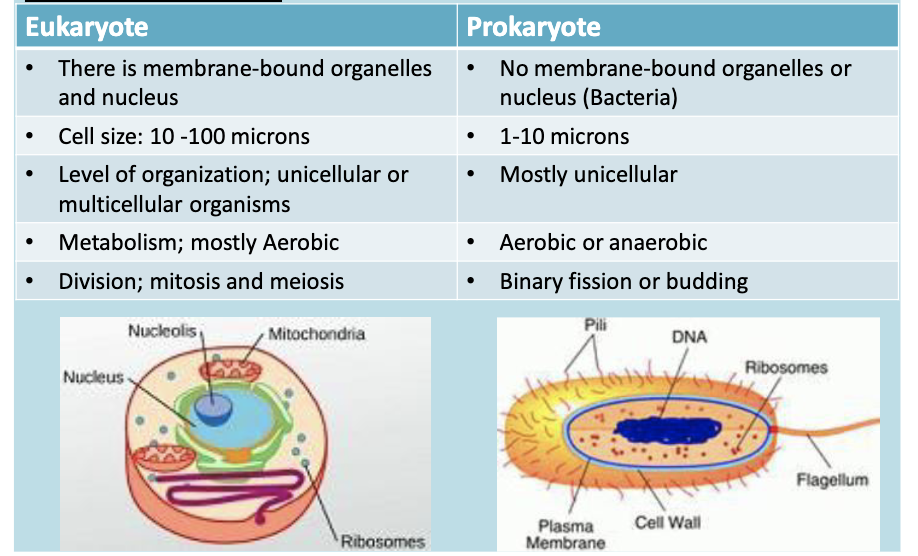
20
New cards
Bases of classification; Level of organization
No organization aggregated cells OR organized cells --> tissue -->
organ --> system
organ --> system

21
New cards
Bases of classification; Body Symmetry
1- Asymmetrical body: Sponges
2- Radial Symmetry: when any plane passing through the central axis
of the body can divide it into identical halves.
3- Symmetrical: When a longitudinal plane passing through the central axis of the body can divide it into identical right and left halves.
2- Radial Symmetry: when any plane passing through the central axis
of the body can divide it into identical halves.
3- Symmetrical: When a longitudinal plane passing through the central axis of the body can divide it into identical right and left halves.
22
New cards
Bases of classification; Body Cavity
Presence or absence of body coelom (cavity) between the body wall, systems, and organs inside the body.
23
New cards
Bases of classification; Body Segmentation
Presence or absence of clear external and internal segmentation of the body e.g. head, neck, chest, abdomen etc.
24
New cards
Bases of classification; Notochord
Presence or absence of Notochord (a cartilaginous skeletal rod supporting the body in all embryonic animals) it is the embryonic form of the vertebral column and spinal cord (+ Chordata).
25
New cards
Seven levels of classification
Kingdom
Phylum
Class
Order
Family
Genus
Species
Phylum
Class
Order
Family
Genus
Species
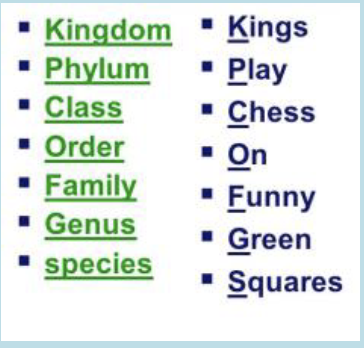
26
New cards
Binomial Nomenclature
1- Names were based on Latin or Ancient Greek words - scientist everywhere understood these languages.
2- The FIRST word of the Scientific Name is the name of the genus (refers to small group of organisms) to which the organism belongs.
3- The SECOND word of the name is the species name (a Latin description of some important characteristic of the organism).
Genus species (italicized)
2- The FIRST word of the Scientific Name is the name of the genus (refers to small group of organisms) to which the organism belongs.
3- The SECOND word of the name is the species name (a Latin description of some important characteristic of the organism).
Genus species (italicized)
27
New cards
Organisms Classification
1- Kingdom Bacteria (Prokaryote)
2- Kingdom Archaea (Prokaryote, e.g. Methanobacetria)
3- Kingdom Protozoa (Amoeba, unicellular)
4- Kingdom Chromista (most of the Algae)
5- Kingdom Plantae (land and water plants)
6- Kingdom Fungi (yeast and mushroom)
7- Kingdom Animalia (All animals)
2- Kingdom Archaea (Prokaryote, e.g. Methanobacetria)
3- Kingdom Protozoa (Amoeba, unicellular)
4- Kingdom Chromista (most of the Algae)
5- Kingdom Plantae (land and water plants)
6- Kingdom Fungi (yeast and mushroom)
7- Kingdom Animalia (All animals)
28
New cards
Taxonomy of Companion animals
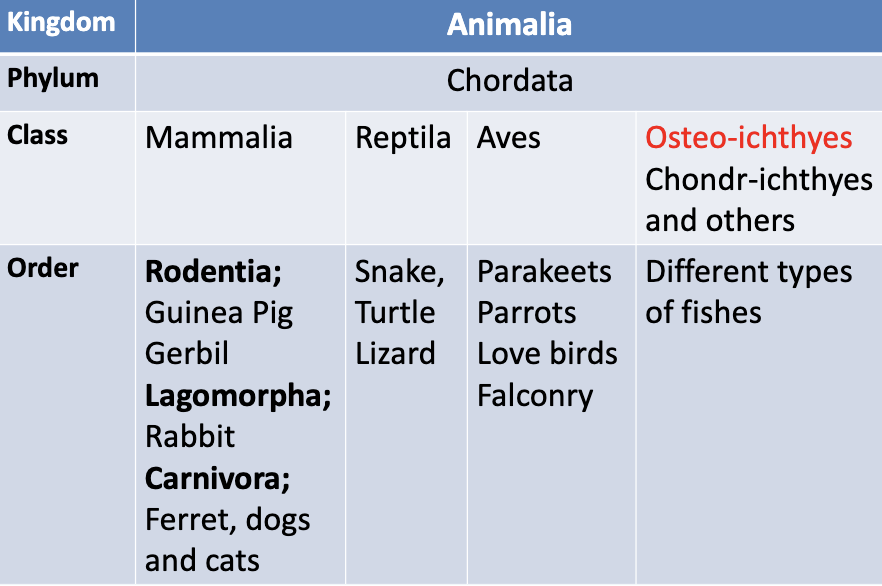
29
New cards
General Characters for class Mammalia
1- Body cover; Most of them have skin covered with hair.
2- Respiration; Air-breathing through a highly developed respiratory
system
3- Feeding newborns; Mammary glands functional in mothers with
young, secrete milk to feed newborns
4- Reproduction; All are viviparous (give birth to a live fetus)
5- Thermoregulation; Homoeothermic - Endothermic mechanism -
warm blood animals, the body keeps it is temperature within a definite
range.
6- Dentation; Heterodonts – have a variety of specialized teeth
(incisors, canines, premolars, and molars) and strong jaws.
7- Musculoskeletal system; All are tetrapod (4 limbs) and a well
developed Skeletal system.
8- Digestive and urogenital systems; Well developed and highly
specialized digestive and urogenital system.
2- Respiration; Air-breathing through a highly developed respiratory
system
3- Feeding newborns; Mammary glands functional in mothers with
young, secrete milk to feed newborns
4- Reproduction; All are viviparous (give birth to a live fetus)
5- Thermoregulation; Homoeothermic - Endothermic mechanism -
warm blood animals, the body keeps it is temperature within a definite
range.
6- Dentation; Heterodonts – have a variety of specialized teeth
(incisors, canines, premolars, and molars) and strong jaws.
7- Musculoskeletal system; All are tetrapod (4 limbs) and a well
developed Skeletal system.
8- Digestive and urogenital systems; Well developed and highly
specialized digestive and urogenital system.
30
New cards
General Characters for class Reptila (Companion animals)
1- Body cover: Their body mostly covered with thick and tough scales
made of a protein called keratin.
2- Respiration; Mostly air breathing through lung (not fully developed as in Mammalia), even the coral sea snake.
3- Reproduction; Mostly Oviparous (lay eggs) with some Viviparous
4- Feeding newborns; Offsprings, can eat directly after being hatched or born, no mammary gland or milk secretion.
5 - Thermoregulation; Poikilotherms – Ectotherms - Cold Blooded
animal: animals whose body temperatures vary according to Ambient
temperature - They have no internal means of regulating metabolic
function nor body temperature.
- In cold weather, snakes tend to be sluggish as their metabolisms
slow down.
6- Dentation; variable pattern, turtles lack teeth, fanged Snakes, and Constrictor snakes.
7- Musculoskeletal system; Most of them are tetrapod, or derived
originally from tetrapod ancestors.
8- Digestive and urogenital system; Cloaca; a single Exit/entrance
opening where excretion of both urine and fecal matter, copulation and
egg laying or parturition occur.
made of a protein called keratin.
2- Respiration; Mostly air breathing through lung (not fully developed as in Mammalia), even the coral sea snake.
3- Reproduction; Mostly Oviparous (lay eggs) with some Viviparous
4- Feeding newborns; Offsprings, can eat directly after being hatched or born, no mammary gland or milk secretion.
5 - Thermoregulation; Poikilotherms – Ectotherms - Cold Blooded
animal: animals whose body temperatures vary according to Ambient
temperature - They have no internal means of regulating metabolic
function nor body temperature.
- In cold weather, snakes tend to be sluggish as their metabolisms
slow down.
6- Dentation; variable pattern, turtles lack teeth, fanged Snakes, and Constrictor snakes.
7- Musculoskeletal system; Most of them are tetrapod, or derived
originally from tetrapod ancestors.
8- Digestive and urogenital system; Cloaca; a single Exit/entrance
opening where excretion of both urine and fecal matter, copulation and
egg laying or parturition occur.
31
New cards
General Characters for class Avis (Companion animals)
1- Body Cover; Their body totally covered with feathers, essential
for thermoregulation, flight, camouflage, and signaling (social and
sexual).
2- Respiration; Air breathing through lung (Birds have one of the
most complex respiratory systems of all animal groups.
- Upon inhalation, 75% of the fresh air bypasses the lungs and flows
directly into a posterior air sac which extends from the lungs and.
connects with air spaces in the bones (pneumonic bones) and fills them
with air.
3- Reproduction; Oviparous (lay hard shelled eggs).
4- Feeding Offsprings, can eat directly after being hatched, no
mammary gland or milk secretion, most of them exhibit parental care
and feeding.
5- Thermoregulation; Homoeothermic, maintains a stable internal
body temperature regardless of external influence.
6- Dentation; Mostly Toothless, and highly modified beaked jaws
according to their feeding habitat
7- Musculoskeletal system; Most of them are tetrapod, with extreme
modifications of the 2 forelimbs into wings.
8- Digestive and urogenital system; Cloaca; a single Exit/entrance
opening where excretion of both urine and fecal matter, copulation
and egg laying occur.
for thermoregulation, flight, camouflage, and signaling (social and
sexual).
2- Respiration; Air breathing through lung (Birds have one of the
most complex respiratory systems of all animal groups.
- Upon inhalation, 75% of the fresh air bypasses the lungs and flows
directly into a posterior air sac which extends from the lungs and.
connects with air spaces in the bones (pneumonic bones) and fills them
with air.
3- Reproduction; Oviparous (lay hard shelled eggs).
4- Feeding Offsprings, can eat directly after being hatched, no
mammary gland or milk secretion, most of them exhibit parental care
and feeding.
5- Thermoregulation; Homoeothermic, maintains a stable internal
body temperature regardless of external influence.
6- Dentation; Mostly Toothless, and highly modified beaked jaws
according to their feeding habitat
7- Musculoskeletal system; Most of them are tetrapod, with extreme
modifications of the 2 forelimbs into wings.
8- Digestive and urogenital system; Cloaca; a single Exit/entrance
opening where excretion of both urine and fecal matter, copulation
and egg laying occur.
32
New cards
General Characters for class Osteo-ichthyes = Fish (Companion animals)
1- Body Cover: Their body totally covered with scales embedded in
the dermal layer of skin, and a lot of mucous secreting glands, secrete
Slime layer.
- A condensed line on both sides of the fish known as the lateral line; is
a sense organ used to detect movement and vibration in the
surrounding water.
2- Respiration: by gills, covered by a common operculum;
respiratory organ for the extraction of oxygen from water and for the
excretion of carbon dioxide.
- “Swim bladder or gas bladder” often present; is an internal organ that
contributes to the ability of a fish to control its buoyancy.
3- Reproduction: Fertilization can be internally or externally, eggs incubation also can be internally or externally with nesting.
4- Feeding Offsprings, can eat directly after being hatched, no
mammary gland or milk secretion.
5- Thermoregulation; Poikilotherms: fishes are so sensitive to sudden
change in water temperature and might lead to temperature shock
and sudden death.
6- Dentation; varies from several shapes, structure and number of
teeth to, very tiny teeth or toothless.
- Carnivores fishes have teeth that are designed to puncture, hold on
to, and cut their prey whereas most fish that eat plants (herbivores)
have teeth that are more suited for shredding things such as algae
7- Musculoskeletal system; Fishes are not tetrapod (The very
ancient fishes used to be classified as tetrapod), they do not have
limbs/ remnant but they do have fins; bony spines or rays
protruding from the body with skin covering them and joining them
together mostly used for swimming and defense.
8- Digestive and urogenital systems; Cloaca; a single Exit/entrance
opening where excretion of both urine and fecal matter, copulation
and egg laying = Spawning occur.
the dermal layer of skin, and a lot of mucous secreting glands, secrete
Slime layer.
- A condensed line on both sides of the fish known as the lateral line; is
a sense organ used to detect movement and vibration in the
surrounding water.
2- Respiration: by gills, covered by a common operculum;
respiratory organ for the extraction of oxygen from water and for the
excretion of carbon dioxide.
- “Swim bladder or gas bladder” often present; is an internal organ that
contributes to the ability of a fish to control its buoyancy.
3- Reproduction: Fertilization can be internally or externally, eggs incubation also can be internally or externally with nesting.
4- Feeding Offsprings, can eat directly after being hatched, no
mammary gland or milk secretion.
5- Thermoregulation; Poikilotherms: fishes are so sensitive to sudden
change in water temperature and might lead to temperature shock
and sudden death.
6- Dentation; varies from several shapes, structure and number of
teeth to, very tiny teeth or toothless.
- Carnivores fishes have teeth that are designed to puncture, hold on
to, and cut their prey whereas most fish that eat plants (herbivores)
have teeth that are more suited for shredding things such as algae
7- Musculoskeletal system; Fishes are not tetrapod (The very
ancient fishes used to be classified as tetrapod), they do not have
limbs/ remnant but they do have fins; bony spines or rays
protruding from the body with skin covering them and joining them
together mostly used for swimming and defense.
8- Digestive and urogenital systems; Cloaca; a single Exit/entrance
opening where excretion of both urine and fecal matter, copulation
and egg laying = Spawning occur.
33
New cards
Do you think that there are some fish that can breathe air outside water with normal lungs?
Yes!
34
New cards
Viruses are considered .... why?
Nonliving, so not prokaryotes or eukaryotes
35
New cards
Are all mammals fully covered by hair?
No, several mammals have little to no body hair (extremely large mammals and fast swimming mammals more specifically)
36
New cards
Are all mammals viviparous?
No; platypus, spiny anteaters lay eggs
37
New cards
Ovoviviparous
eggs incubated and hatched inside the female's body
38
New cards
What is crop milk?
Secretion from the GI tract of parent birds (from the crop)
39
New cards
What is mouthbrooding fish?
Fish can lay eggs --> fertilized eggs in mouth
Fish can keep larvae in mouth
Eggs inside mouth (ovophile or larvophile)
Fish can keep larvae in mouth
Eggs inside mouth (ovophile or larvophile)
40
New cards
Problems related to breeding immature female
1.) Physical immaturity --> animal has not yet reached full body size yet
- They have an incomplete musculoskeletal system, meaning they have
a narrow pelvis which can cause dystocia. It will also cause a small-
sized/premature fetus bc their body system is not fully developed, they
need special care or they might die.
- Underdeveloped mammary glands lower the output starvation of
offsprings, reduced colostrum --> weak offsprings with reduced
immunity
- Arrested growth of the female: once pregnancy occurs, all nutrients
will be directed or even withdrawn from the body or even withdrawn
from the body to supply feti which will in return arrests the development
of the female.
2.) Sexual immaturity --> the animal did not reach full reproductive
performance.
- Irregular estrus cycle (the regular reproductive cycle in females)
- Weak ovulation; includes number of ova, and quality of ova.
- Lower conception rate (ratio of successful mating that ended with
pregnancy)
- Incomplete development of reproductive organs; To assure that
reproductive organ e.g. uterus, vagina and vulva reached full size;
immature or juvenile reproductive organs might lead to bleeding and
pain during copulation or parturition, early abortion and dystocia.
3.) Mental Immaturity: the animal did not reach full mental development and can take care of offspring
- Maternal rejection ; the highest recorded % of offspring rejection was
recorded after the first birth particularly for early bred females (Reject to
take care and nurse).
- Maternal aggression
- Maternal cannibalism (Common in rabbit as well)
- They have an incomplete musculoskeletal system, meaning they have
a narrow pelvis which can cause dystocia. It will also cause a small-
sized/premature fetus bc their body system is not fully developed, they
need special care or they might die.
- Underdeveloped mammary glands lower the output starvation of
offsprings, reduced colostrum --> weak offsprings with reduced
immunity
- Arrested growth of the female: once pregnancy occurs, all nutrients
will be directed or even withdrawn from the body or even withdrawn
from the body to supply feti which will in return arrests the development
of the female.
2.) Sexual immaturity --> the animal did not reach full reproductive
performance.
- Irregular estrus cycle (the regular reproductive cycle in females)
- Weak ovulation; includes number of ova, and quality of ova.
- Lower conception rate (ratio of successful mating that ended with
pregnancy)
- Incomplete development of reproductive organs; To assure that
reproductive organ e.g. uterus, vagina and vulva reached full size;
immature or juvenile reproductive organs might lead to bleeding and
pain during copulation or parturition, early abortion and dystocia.
3.) Mental Immaturity: the animal did not reach full mental development and can take care of offspring
- Maternal rejection ; the highest recorded % of offspring rejection was
recorded after the first birth particularly for early bred females (Reject to
take care and nurse).
- Maternal aggression
- Maternal cannibalism (Common in rabbit as well)
41
New cards
Structures & Functions of Female Repro Tract
- Ovaries are the female gonads; they contain the Ova and are responsible for much of the animal's reproductive hormone production.
- Oviducts are small ducts that transport the ova from the ovary to the uterus, and where fertilization mostly occur.
- Uterine horns join and form the uterine body anterior to the cervix (Remember that anterior means toward the head of the animal)
- Cervix is a structure consisting of dense muscular and connective tissue tube that connects the uterus to the vagina; (the firm closure of the cervix after Fertilization is essential for Pregnancy)
- Vagina is the female copulatory organ that opens at the external
genitalia, or vulva.
- Oviducts are small ducts that transport the ova from the ovary to the uterus, and where fertilization mostly occur.
- Uterine horns join and form the uterine body anterior to the cervix (Remember that anterior means toward the head of the animal)
- Cervix is a structure consisting of dense muscular and connective tissue tube that connects the uterus to the vagina; (the firm closure of the cervix after Fertilization is essential for Pregnancy)
- Vagina is the female copulatory organ that opens at the external
genitalia, or vulva.
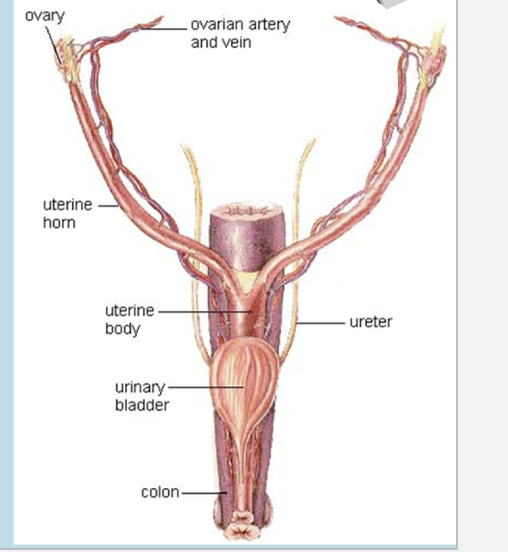
42
New cards
Structures & Functions of Male Repro Tract
- Testicles: Male gonads, Kept outside the body cavity in the scrotum; (must be kept in a lower temperature than body temp.), they are responsible for production of sperms, and secretion of Androgen (Testosterone).
- Epididymis: a highly convoluted duct behind the testis, composed of the head body, and tail, the later is connected directly to the ductus deferens which lead to the penile urethra.
1- Store and protect spermatozoa
2- Act as a recycling center for damaged spermatozoa
3- Facilitates functional maturation of spermatozoa
- Scrotum and prepuce: Skin pouch and a Skin sheath that enclose testacies and penis (Cremasteric muscle).
- Accessory genital glands: (Seminal vesicles - Prostate gland- Bulbourethral glands)
1- Secretes seminal plasma to nourish and activate the spermatozoa
2- Clear the urethral tract prior to ejaculation (optimize pH)
3- Serve as the vehicle of transport of the spermatozoa in male and the
female tract
- Epididymis: a highly convoluted duct behind the testis, composed of the head body, and tail, the later is connected directly to the ductus deferens which lead to the penile urethra.
1- Store and protect spermatozoa
2- Act as a recycling center for damaged spermatozoa
3- Facilitates functional maturation of spermatozoa
- Scrotum and prepuce: Skin pouch and a Skin sheath that enclose testacies and penis (Cremasteric muscle).
- Accessory genital glands: (Seminal vesicles - Prostate gland- Bulbourethral glands)
1- Secretes seminal plasma to nourish and activate the spermatozoa
2- Clear the urethral tract prior to ejaculation (optimize pH)
3- Serve as the vehicle of transport of the spermatozoa in male and the
female tract
43
New cards
Reproductive Physiology in male
A.) Sperm Pass-way
1- Spermatozoa are produced in testes in the seminiferous tubules;
Seminiferous tubules are tightly coiled tubes found in lobules of
testes.
2- Sperms are passed into small tubules and collected at the rete
testes
3- From rete testes sperms leave the testes by efferent ductules and
collected in the head of epididymis.
4- Then sperms pass through the tail of Epididymis to the ductus
deference, then passed to the ejaculatory duct which is connected to
the urethra.
B.) Sperm production; spermatogenesis
1- Spermatocytogenesis; in which the primitive stem cell
(Spermatogonia = the precursor cell of sperms) dividing to replace
themselves and to produce a population of cells later develop into
mature sperm.
2- Spermiogenesis: is the final stage of spermatogenesis, which sees
the maturation of spermatids into mature, motile spermatozoa. The
spermatid is a more or less circular cell containing a nucleus.
3- Spermiation: is the process by which mature spermatids are released
from seminiferous tubule lumen to the ductules prior to their passage to
the epididymis.
1- Spermatozoa are produced in testes in the seminiferous tubules;
Seminiferous tubules are tightly coiled tubes found in lobules of
testes.
2- Sperms are passed into small tubules and collected at the rete
testes
3- From rete testes sperms leave the testes by efferent ductules and
collected in the head of epididymis.
4- Then sperms pass through the tail of Epididymis to the ductus
deference, then passed to the ejaculatory duct which is connected to
the urethra.
B.) Sperm production; spermatogenesis
1- Spermatocytogenesis; in which the primitive stem cell
(Spermatogonia = the precursor cell of sperms) dividing to replace
themselves and to produce a population of cells later develop into
mature sperm.
2- Spermiogenesis: is the final stage of spermatogenesis, which sees
the maturation of spermatids into mature, motile spermatozoa. The
spermatid is a more or less circular cell containing a nucleus.
3- Spermiation: is the process by which mature spermatids are released
from seminiferous tubule lumen to the ductules prior to their passage to
the epididymis.
44
New cards
Physiology of gestation
1- Fertilization; is a cell-cell recognition process that occurs between two distinct cells: a - small asymmetric and motile sperm cell and a large and nonmotile egg.
- Eggs: A nonmotile cell contain haploid nucleus, surrounded by a
highly protective layer called Zuna pellucida.
- Sperm: Small and motile cells composed of 3 parts;
1.) Head: Contains the spermatic haploid nucleus. Overlaying the
head is a membrane-bound vesicle, called “acrosome”, it is a
lysosomal-like structure that contains hydrolases and protease
enzymes
2.) Midpiece: The proximal portion of the tail, contains
mitochondria, which produce the ATP necessary for the beating of
the tail.
3.) Tail: Contains the flagellar apparatus, which is responsible for
motility.
- Eggs: A nonmotile cell contain haploid nucleus, surrounded by a
highly protective layer called Zuna pellucida.
- Sperm: Small and motile cells composed of 3 parts;
1.) Head: Contains the spermatic haploid nucleus. Overlaying the
head is a membrane-bound vesicle, called “acrosome”, it is a
lysosomal-like structure that contains hydrolases and protease
enzymes
2.) Midpiece: The proximal portion of the tail, contains
mitochondria, which produce the ATP necessary for the beating of
the tail.
3.) Tail: Contains the flagellar apparatus, which is responsible for
motility.
45
New cards
Stages of fertilization
1) Sperm preparation:
- Ejaculated sperms are not ready to fertilize an egg when they enter
the vagina, they undergo several changes, which are collectively
known as Capacitation: The physiological changes of spermatozoa in
order to have the ability to penetrate and fertilize an egg, usually occur
as a response to the semen being diluted by vaginal secretions.
- This process results in:
* increasing the spermatic motility and the sperm tail beat more
powerfully and regularly
* losing of the sperm’s surface antigens (losing the electrical
charges responsible for repulsion force).
2) Sperm-egg recognition and binding
- Chemoattraction; Simply the egg produce chemical attractants to the
sperms then, there are egg binding receptors on sperms and sperm
binding receptors on the egg, this initiate a process of attraction and
binding between them.
- Vaginal and uterine contraction, oviduct cilia , chemoattractant and
receptors
3) Sperm-egg fusion.
- Acrosome reaction: Sperm- egg binding stimulate lysis of the
acrosome membrane and release of the hydrolases and protease
enzymes, these enzyme penetrate through the outer layer of egg wall.
- Sperm nucleus and other organelles are incorporated into the egg
cytoplasm.
- The sperm nucleus undergoes a series of changes, result in formation
of male pronucleus (that can bind with the egg pronucleus) and
forming the diploid nucleus.
- Other sperm organelles remain active inside the new diploid cell and
participate in the early development.
4) Zygote activation:
- Prevention of polyspermy (refers to the fertilization of the egg by more
than one sperm, resulting in zygotes with greater than a diploid amount
of DNA. this causes early embryonic defects and arrest of
development):
- Immediately after pronuclei fusion the fertilized ovum produce several
enzymes which form a protective layer around the fertilized ovum act as
physical, and chemical barriers or even have a spermicidal effect.
- Finally the cellular metabolism, protein synthesis and mitotic division
are progressively upregulated to initiate zygote cleavage and embryo
formation.
- Ejaculated sperms are not ready to fertilize an egg when they enter
the vagina, they undergo several changes, which are collectively
known as Capacitation: The physiological changes of spermatozoa in
order to have the ability to penetrate and fertilize an egg, usually occur
as a response to the semen being diluted by vaginal secretions.
- This process results in:
* increasing the spermatic motility and the sperm tail beat more
powerfully and regularly
* losing of the sperm’s surface antigens (losing the electrical
charges responsible for repulsion force).
2) Sperm-egg recognition and binding
- Chemoattraction; Simply the egg produce chemical attractants to the
sperms then, there are egg binding receptors on sperms and sperm
binding receptors on the egg, this initiate a process of attraction and
binding between them.
- Vaginal and uterine contraction, oviduct cilia , chemoattractant and
receptors
3) Sperm-egg fusion.
- Acrosome reaction: Sperm- egg binding stimulate lysis of the
acrosome membrane and release of the hydrolases and protease
enzymes, these enzyme penetrate through the outer layer of egg wall.
- Sperm nucleus and other organelles are incorporated into the egg
cytoplasm.
- The sperm nucleus undergoes a series of changes, result in formation
of male pronucleus (that can bind with the egg pronucleus) and
forming the diploid nucleus.
- Other sperm organelles remain active inside the new diploid cell and
participate in the early development.
4) Zygote activation:
- Prevention of polyspermy (refers to the fertilization of the egg by more
than one sperm, resulting in zygotes with greater than a diploid amount
of DNA. this causes early embryonic defects and arrest of
development):
- Immediately after pronuclei fusion the fertilized ovum produce several
enzymes which form a protective layer around the fertilized ovum act as
physical, and chemical barriers or even have a spermicidal effect.
- Finally the cellular metabolism, protein synthesis and mitotic division
are progressively upregulated to initiate zygote cleavage and embryo
formation.
46
New cards
Zygote
diploid cell resulting from the fusion of two haploid gametes; a fertilized ovum
47
New cards
Sperm capacitation
the physiological changes spermatozoa must undergo in order to have the ability to penetrate and fertilize an egg
48
New cards
Polyspermy
refers to the fertilization of the egg by more than one sperm, resulting in zygotes with greater than a diploid amount of DNA. this causes early embryonic defects and arrest of development
49
New cards
Different types of estrus cycle
1- Monoestrous; Having only one estrus cycle annually per year
e.g. Dogs, wolves, foxes and bears.
2- Polyestrous: having several estrus cycles throughout the year
e.g. House Cats, Cows and Pigs.
3- Seasonal polyestrous; having several estrus cycles during particular season = Breeding season.
e.g. (Short day Breeders = Winter and fall ); Sheep, Goat and Deer,
e.g. (Long day Breeders = Summer and spring); Horses, Hamster and
Ferrets.
e.g. Dogs, wolves, foxes and bears.
2- Polyestrous: having several estrus cycles throughout the year
e.g. House Cats, Cows and Pigs.
3- Seasonal polyestrous; having several estrus cycles during particular season = Breeding season.
e.g. (Short day Breeders = Winter and fall ); Sheep, Goat and Deer,
e.g. (Long day Breeders = Summer and spring); Horses, Hamster and
Ferrets.
50
New cards
Different types of ovulation
1- Spontaneous Ovulation: ovulation is spontaneously following hormonal cyclicity of the body
e.g. Cows, dogs, Horses
2 - Induced Ovulation: ovulation usually induced by the stimulus produced by coitus
e.g. Cats, Rabbit, Ferrets, and Camels
e.g. Cows, dogs, Horses
2 - Induced Ovulation: ovulation usually induced by the stimulus produced by coitus
e.g. Cats, Rabbit, Ferrets, and Camels
51
New cards
Study Guide for Estrus Cycle
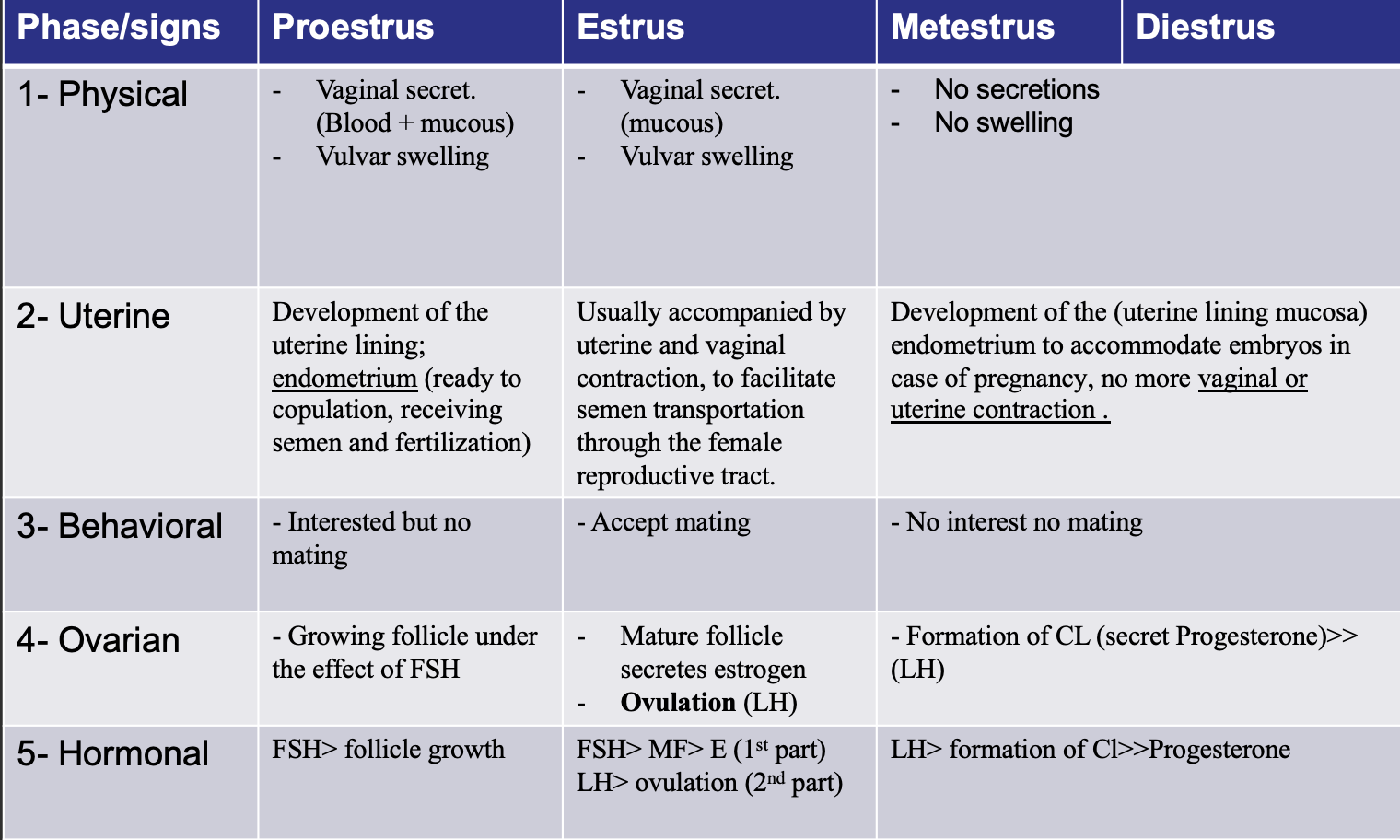
52
New cards
Stages of Estrus Cycle
1- Proestrus Phase (Preparatory stage – NO sexual reception)
2- Estrus Phase (Ovulation, sexual reception and mating)
3- Metestrus or Diestrus phase (After-mating – NO sexual reception)
4- *Anestrus phase (Sexual Inactivity – NO sexual reception)
2- Estrus Phase (Ovulation, sexual reception and mating)
3- Metestrus or Diestrus phase (After-mating – NO sexual reception)
4- *Anestrus phase (Sexual Inactivity – NO sexual reception)
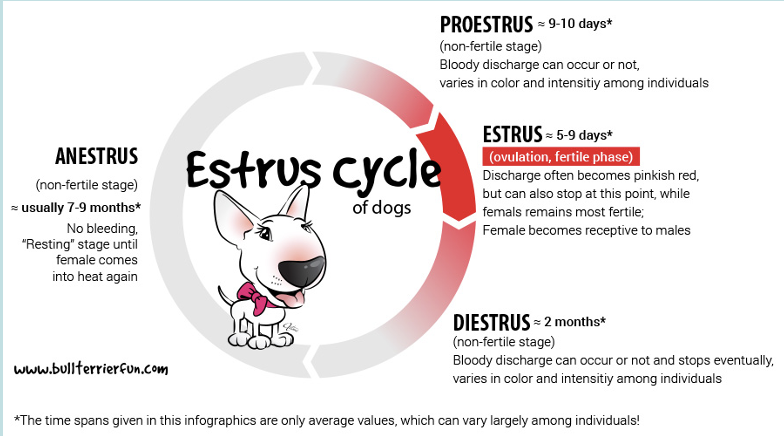
53
New cards
Changes during Estrus Cycle
1- Ovarian changes
2- Uterine changes
3- Physical changes
4- Behavioral changes
5- *Hormonal changes
2- Uterine changes
3- Physical changes
4- Behavioral changes
5- *Hormonal changes
54
New cards
1- Proestrus Phase
1- Ovarian changes; The first stage of estrus cycle, one or more follicles (contain oocyte or ova) start to grow on ovaries.
2- Uterine changes; Development (proliferation) of the uterine lining; endometrium (ready to copulation, receiving semen and fertilization).
3- Physical changes; Usually accompanied by vaginal secretions (mucous, blood or mixed) and swelling and redness of the vulva.
4- Behavioral changes; Females will show interest in males but will never accept mating.
2- Uterine changes; Development (proliferation) of the uterine lining; endometrium (ready to copulation, receiving semen and fertilization).
3- Physical changes; Usually accompanied by vaginal secretions (mucous, blood or mixed) and swelling and redness of the vulva.
4- Behavioral changes; Females will show interest in males but will never accept mating.
55
New cards
2- Estrus Phase (Ovulation and sexual reception)
1- Behavioral changes; Females exhibit sexually receptive behavior (“In heat”) and stand to be mounted.
2- Physical changes; valvar swelling and vaginal secretions (mucous only) to facilitate copulation and sperm motility after copulation.
3- Uterine changes; Usually accompanied by uterine and vaginal contraction, to facilitate semen transportation through the female reproductive tract.
4- Ovarian changes; Follicles are mature and ready to ovulate
(Mature Follicle; MF, secrets Estrogen).
- Ovulation (release of the ova from the ovary to the oviduct for
fertilization) usually occur in this stage or slightly after, this period
terminates with ovulation.
2- Physical changes; valvar swelling and vaginal secretions (mucous only) to facilitate copulation and sperm motility after copulation.
3- Uterine changes; Usually accompanied by uterine and vaginal contraction, to facilitate semen transportation through the female reproductive tract.
4- Ovarian changes; Follicles are mature and ready to ovulate
(Mature Follicle; MF, secrets Estrogen).
- Ovulation (release of the ova from the ovary to the oviduct for
fertilization) usually occur in this stage or slightly after, this period
terminates with ovulation.
56
New cards
Ovulation
when a mature ovum (oocyte) is released from the MF on ovary, pushed down the oviduct = fallopian tube, and is made available to be fertilized.
57
New cards
3- Metestrus or Diestrus phase
1- Uterine changes;
- Development of the (uterine lining mucosa) endometrium to accommodate embryos in case of pregnancy
- Calming; no more vaginal or uterine contraction .
2- Physical changes; NO MORE vaginal secretion and vulvar swelling.
3- Behavioral changes; Females are not receptive to males anymore and might attack the male if tries to mount.
4- Ovarian changes; Remnants of the follicle after ovulation will form a yellow colored structure on the ovaries called:
(Corpus Luteum - CL secretes Progesterone)
- This period starts by formation of CL and will ends by regression of the CL
- Development of the (uterine lining mucosa) endometrium to accommodate embryos in case of pregnancy
- Calming; no more vaginal or uterine contraction .
2- Physical changes; NO MORE vaginal secretion and vulvar swelling.
3- Behavioral changes; Females are not receptive to males anymore and might attack the male if tries to mount.
4- Ovarian changes; Remnants of the follicle after ovulation will form a yellow colored structure on the ovaries called:
(Corpus Luteum - CL secretes Progesterone)
- This period starts by formation of CL and will ends by regression of the CL
58
New cards
4- Anestrus phase
- Period of sexual inactivity or rest between cycles.
- Length varies according to several factors include;
* Time of the year (seasonality)
* Pregnancy
* Lactation
* Age of the animal
- Not in All animals.
- Length varies according to several factors include;
* Time of the year (seasonality)
* Pregnancy
* Lactation
* Age of the animal
- Not in All animals.
59
New cards
Endocrinology of female reproduction
Hypothalamus: is a section of the brain responsible for the production of many of the body's essential hormones.
- It secretes several releasing Hs; thyrotropin-releasing hormone (TRH),
corticotrophin releasing hormone (CHR), etc.
- It also secretes GnRH; Gonadotrophic Releasing H which stimulates
Anterior Pituitary gland to Secret:
* Gonadotrophic Hs:
1- FSH; Follicle Stimulating H 2- LH; Luteinizing H.
- It secretes several releasing Hs; thyrotropin-releasing hormone (TRH),
corticotrophin releasing hormone (CHR), etc.
- It also secretes GnRH; Gonadotrophic Releasing H which stimulates
Anterior Pituitary gland to Secret:
* Gonadotrophic Hs:
1- FSH; Follicle Stimulating H 2- LH; Luteinizing H.
60
New cards
FSH
- Responsible for growth and maturation of the Follicle (contains ovum).
- Secreted in high level usually during proestrus and early stage of estrus phase, till formation of the MF.
- Secreted in high level usually during proestrus and early stage of estrus phase, till formation of the MF.
61
New cards
LH
- Responsible for Ovulation and formation of Corpus Luteum.
- Secreted in a high level just before ovulation during Estrus phase, and formation of CL during Diestrus.
- Secreted in a high level just before ovulation during Estrus phase, and formation of CL during Diestrus.
62
New cards
Estrogen
Mature Follicle is responsible for secreting it
(E2) responsible for; All the signs of estrus phase including;
* Vaginal discharge
* Uterine contraction
* Male receptivity
(E2) responsible for; All the signs of estrus phase including;
* Vaginal discharge
* Uterine contraction
* Male receptivity
63
New cards
Corpus Luteum
responsible for secreting; Progesterone (P4)
64
New cards
Progesterone (P4)
P4 is responsible for; All signs of Metestrus/anestrus phase including;
- Preparation and calming of the uterine wall to receive embryos.
- Cessation of male reception
- Preparation and calming of the uterine wall to receive embryos.
- Cessation of male reception
65
New cards
Hormones & their functions chart
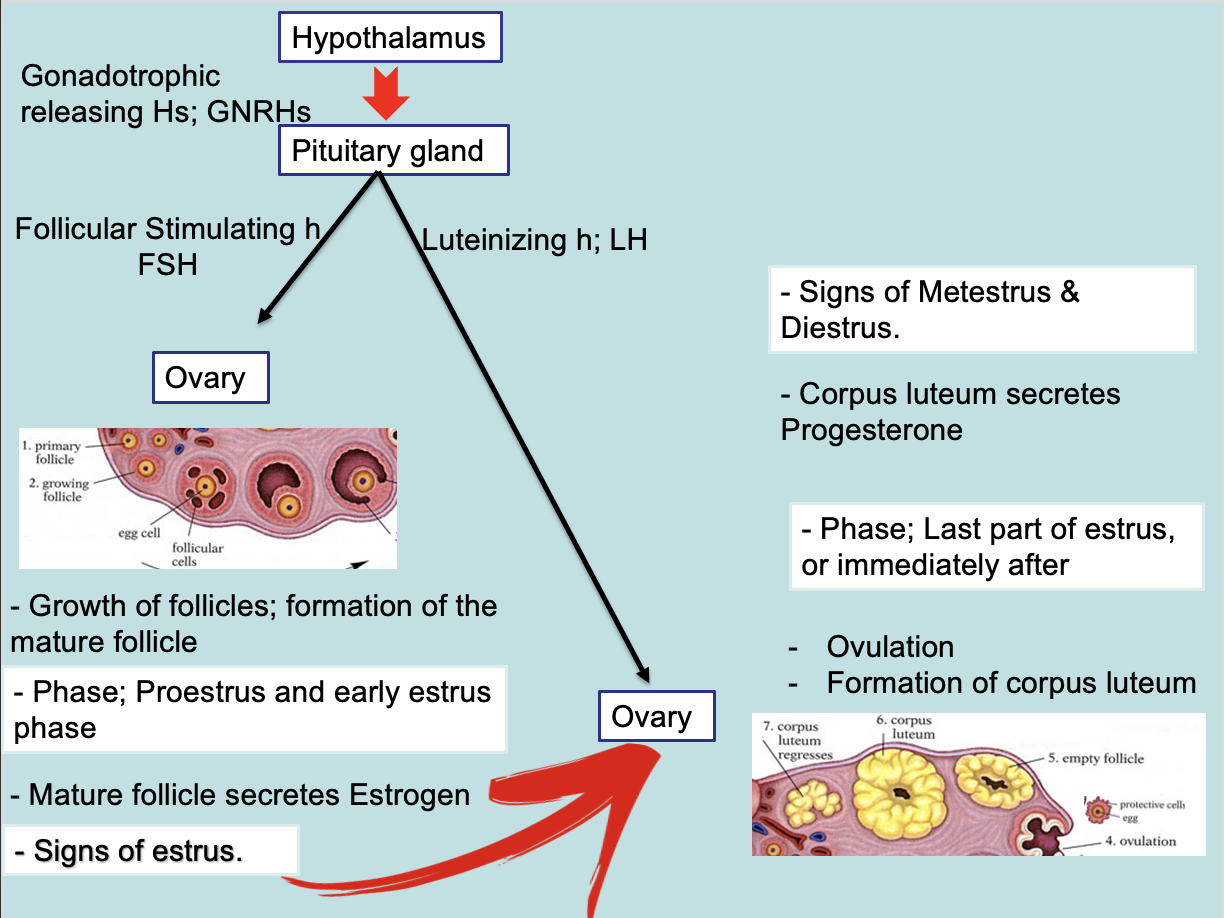
66
New cards
Some animals have one uterus and others might have 2 cervices, do any animals have 2/3 vaginas?
Yes, marsupials do!
67
New cards
What happens to sperm after 24 hours/if an animal doesn't ejaculate?
Sperm will stay/be stored in the tail of the epididymis and if not ejaculated it will be recycled and energy reused in the body. Stored for various amounts of time in different animals, 24-36 hours for dogs and horses, 4-6 hours for cats, elephants 7-10 days.
68
New cards
How much semen does a golden retriever produce?
~5 mL (< .25 mL of this is sperm)
69
New cards
Do birds have testes?
Yes, they are internal. Testes function normally in high body temp and testes are cooled by the pelvic air sac.
70
New cards
What is Nutrition?
- Science of dealing with the utilization of food by the body processes, which transform food into body tissues and energy.
71
New cards
What is a Nutrient?
- Is a component in foods that an organism uses to survive and grow.
1. Water
2. Carbohydrates
3. Fats
4. Protein
5. Minerals
6. Vitamins
1. Water
2. Carbohydrates
3. Fats
4. Protein
5. Minerals
6. Vitamins
72
New cards
Water
1- Water is the major constituent of animal’s body and probably the most important nutrient!
- Making up, on average, 75% at birth and 60% in adult life
- Lean muscle tissue contains about 75% water, blood contains 70 - 80%
water, body fat contains 14% water and bone has 22% water, brain ~60 %
water and lungs about 70% water.
2- Most animals can live one to two weeks or longer without food, but can only live a couple of days without water. (There are some exceptions)
- Making up, on average, 75% at birth and 60% in adult life
- Lean muscle tissue contains about 75% water, blood contains 70 - 80%
water, body fat contains 14% water and bone has 22% water, brain ~60 %
water and lungs about 70% water.
2- Most animals can live one to two weeks or longer without food, but can only live a couple of days without water. (There are some exceptions)
73
New cards
Water's Role in the Body
1- Thermoregulation;
- Involved in most of the heat loss process; Sweating, Panting
(evaporative cooling) from the respiratory system, Urination and avian
defecation.
2- Major component of most body fluids;
- Digestion; Saliva, gastric juice and intestinal secretions.
- Blood; transports nutrients to all body tissues and removes wastes from those tissues.
- Cerebrospinal (CS) fluid; protection, nourishment of the CNS, and help in transportation of nerve impulses.
- Excretion; urine and fecal matter
- Lubrication of joints (part of the Synovial fluid ), part of the eyes lacrimal secretion (prevent eye dryness) and inner ear secretion (help in sound transmission), etc.
3- Required for most of the body metabolic processes; fat, protein and CHO digestion, and all the anabolic processes for tissues build up.
4- Important for Ion balance (Osmotic pressure) across cellular membranes.
- Involved in most of the heat loss process; Sweating, Panting
(evaporative cooling) from the respiratory system, Urination and avian
defecation.
2- Major component of most body fluids;
- Digestion; Saliva, gastric juice and intestinal secretions.
- Blood; transports nutrients to all body tissues and removes wastes from those tissues.
- Cerebrospinal (CS) fluid; protection, nourishment of the CNS, and help in transportation of nerve impulses.
- Excretion; urine and fecal matter
- Lubrication of joints (part of the Synovial fluid ), part of the eyes lacrimal secretion (prevent eye dryness) and inner ear secretion (help in sound transmission), etc.
3- Required for most of the body metabolic processes; fat, protein and CHO digestion, and all the anabolic processes for tissues build up.
4- Important for Ion balance (Osmotic pressure) across cellular membranes.
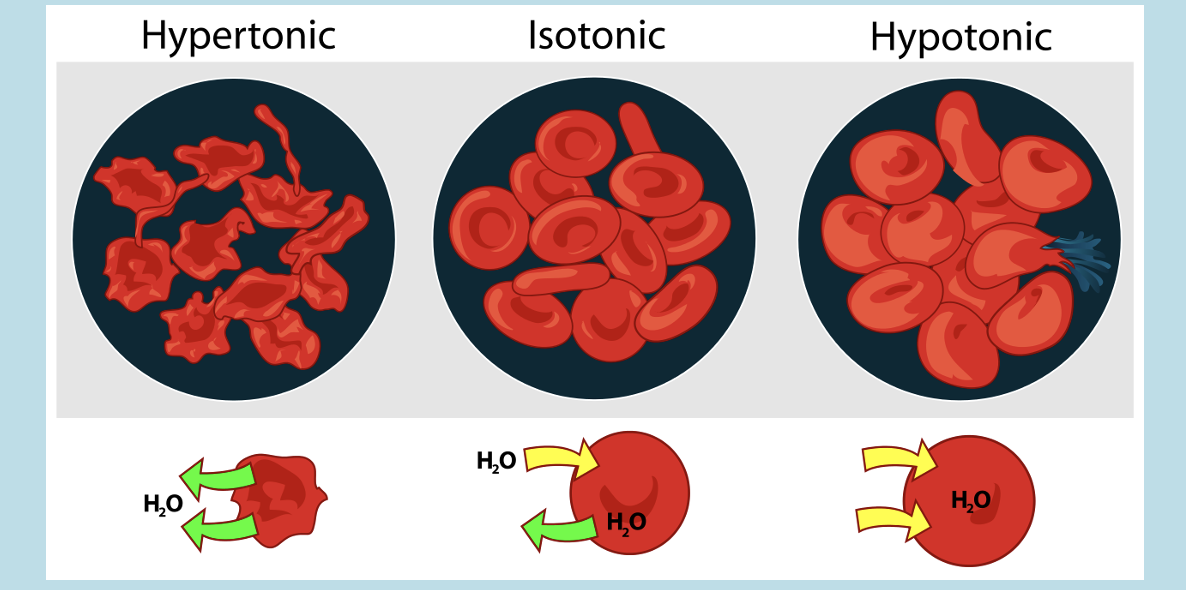
74
New cards
Common Sources of Water
1- Drinking water
2- Water contained in the food
3- Water from metabolic breakdown of fats, proteins and carbohydrates.
2- Water contained in the food
3- Water from metabolic breakdown of fats, proteins and carbohydrates.
75
New cards
Water Deficiency
- Water Deficiency in the body = Dehydration, a loss of 5 to 10% of body water, will result in severe dehydration and cell functions diminish to prolonged dehydration can lead to death
- Dehydration might be due to reduction in water input (Always make sure fresh clean water is available to your pet) OR increase water loss.
- Dehydration might be due to reduction in water input (Always make sure fresh clean water is available to your pet) OR increase water loss.
76
New cards
Body Water loss: Physiological causes
1- Urine is the largest water loss out of the body – about 75 to 85 % of total water loss.
2- Fecal matter is the 2nd largest water loss; Dog and cat poop is about 60% water.
3- Respiration thru the lungs is also a mechanism of water loss from the body. (why not sweating?). This can be a major loss especially during exercise or in hot weather.
4- Lactation is also a major water loss.
Most milk is 10 -15% solids and 85 – 90% water.
2- Fecal matter is the 2nd largest water loss; Dog and cat poop is about 60% water.
3- Respiration thru the lungs is also a mechanism of water loss from the body. (why not sweating?). This can be a major loss especially during exercise or in hot weather.
4- Lactation is also a major water loss.
Most milk is 10 -15% solids and 85 – 90% water.
77
New cards
Body Water loss: Pathological causes
Diarrhea and Vomiting, etc
78
New cards
Signs of Dehydration
Sunken eyes.
Dry, pale gums (Capillary refill time).
Loss of skin elasticity – (Skin tent test)
Weakness, collapse and ultimately death.
Dry, pale gums (Capillary refill time).
Loss of skin elasticity – (Skin tent test)
Weakness, collapse and ultimately death.
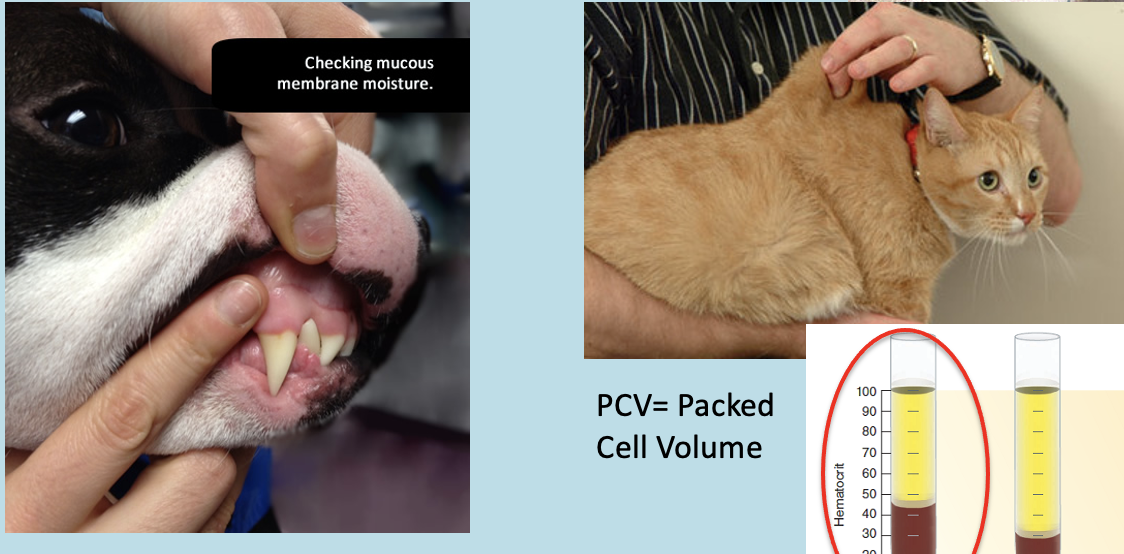
79
New cards
Calculating amount of water needed for an animal
For every kilocalorie (kcal) >>>
An animal will require at least 1 ml/cc of H2O.
An animal will require at least 1 ml/cc of H2O.
80
New cards
Carbohydrates, CHO
1- Carbohydrates are molecules composed of Carbon, Oxygen and Hydrogen, they are mainly of vegetable origin, with the exception of blood glucose, glycogen in the muscles and liver, and milk sugar “Lactose”.
- The most common carbohydrate is (Glucose = Absorbable form) and it
is the second most important nutrient after water (the main source of
energy).
2- All animals and humans must maintain a constant level of blood glucose, a sudden change in that level might result in a major health problem or even lead to death.
3- Blood Glucose level in Ruminant is usually lower than mono-gastric animals;
- The most common carbohydrate is (Glucose = Absorbable form) and it
is the second most important nutrient after water (the main source of
energy).
2- All animals and humans must maintain a constant level of blood glucose, a sudden change in that level might result in a major health problem or even lead to death.
3- Blood Glucose level in Ruminant is usually lower than mono-gastric animals;
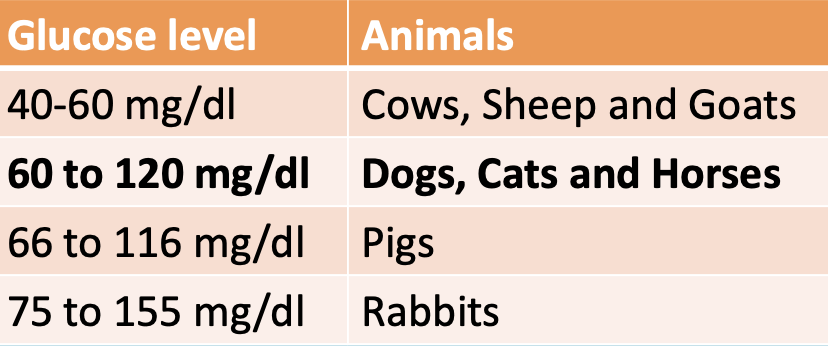
81
New cards
CHO role in body
1- Glucose is the main source of utilizable energy (the body will convert any substance to glucose, then cells will metabolize glucose to produce energy).
- This energy used for all the physiological processes such as
respiration, muscle contraction and relaxation, heart rhythm and the
regulation of body temperature.
2- Brain Fuel; The brain, neurons and developing red blood cells can only use glucose for energy.
- If your intake of carbohydrates is inadequate, your body will draw on
glycogen and fat stores to give the brain fuel >> Once the stores fail,
the body begins to break down muscle tissue to make glucose in a
process called CATABOLISM.
- This energy used for all the physiological processes such as
respiration, muscle contraction and relaxation, heart rhythm and the
regulation of body temperature.
2- Brain Fuel; The brain, neurons and developing red blood cells can only use glucose for energy.
- If your intake of carbohydrates is inadequate, your body will draw on
glycogen and fat stores to give the brain fuel >> Once the stores fail,
the body begins to break down muscle tissue to make glucose in a
process called CATABOLISM.
82
New cards
CHO Classification (Chemical)
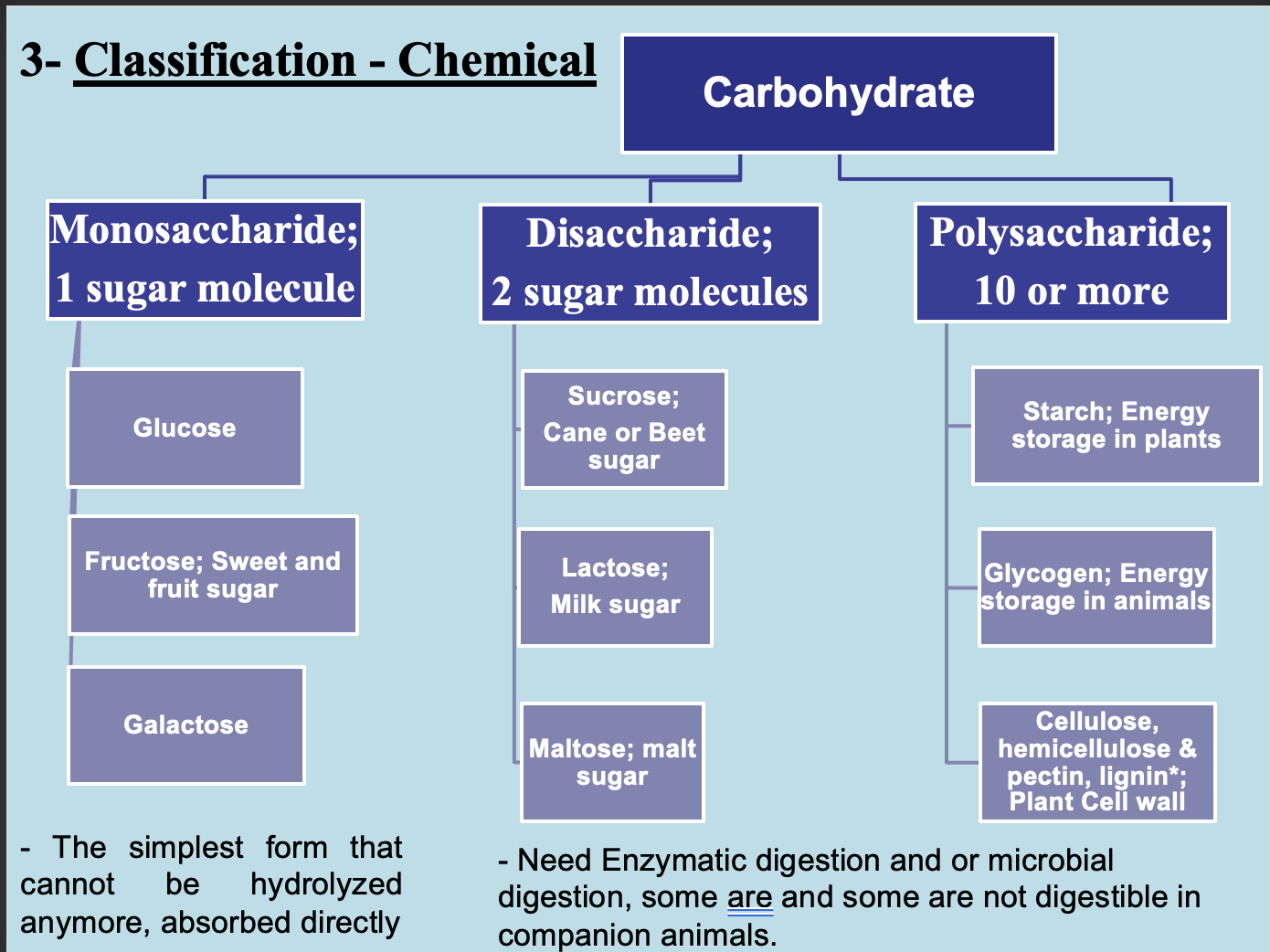
83
New cards
CHO Classification (Biological)
1. Absorbable CHO – a form that is immediately useable by
the body e.g. Glucose, galactose and Fructose, usually present as a component of more complex carbohydrates which must be degraded by enzymes.
2. Digestible carbohydrate – mainly starch, from plant origin and Glycogen from animal sources>> Broken down by enzymes into absorbable carbohydrates.
3. Fermentable carbohydrate – utilized by bacteria in the gut and may be broken down into a form useable by the body e.g. pectin.
4. Non-fermentable and insoluble carbohydrate (in mono-gastric companion animals) – commonly known as fibers, this category of carbohydrate passes through the body undigested (e.g. lignin, cellulose and hemicellulose) and serves to add bulk to the bowel contents.
the body e.g. Glucose, galactose and Fructose, usually present as a component of more complex carbohydrates which must be degraded by enzymes.
2. Digestible carbohydrate – mainly starch, from plant origin and Glycogen from animal sources>> Broken down by enzymes into absorbable carbohydrates.
3. Fermentable carbohydrate – utilized by bacteria in the gut and may be broken down into a form useable by the body e.g. pectin.
4. Non-fermentable and insoluble carbohydrate (in mono-gastric companion animals) – commonly known as fibers, this category of carbohydrate passes through the body undigested (e.g. lignin, cellulose and hemicellulose) and serves to add bulk to the bowel contents.
84
New cards
Regulation of Glucose in Body
Insulin:
- Decrease Blood Glucose Level
- Stimulate Glycolysis; Cellular uptake and metabolism of glucose.
- Stimulate Glycogenesis in muscle, liver and fat tissue (conversion of glucose into glycogen and stroage).
Glucagon
- Increase Blood Glucose Level
- Stimulate Satiety and hunger center in the brain initiate hunger.
- Stimulate Glycogenolysis and Gluconeogenesis from non-CHO source
- Decrease Blood Glucose Level
- Stimulate Glycolysis; Cellular uptake and metabolism of glucose.
- Stimulate Glycogenesis in muscle, liver and fat tissue (conversion of glucose into glycogen and stroage).
Glucagon
- Increase Blood Glucose Level
- Stimulate Satiety and hunger center in the brain initiate hunger.
- Stimulate Glycogenolysis and Gluconeogenesis from non-CHO source
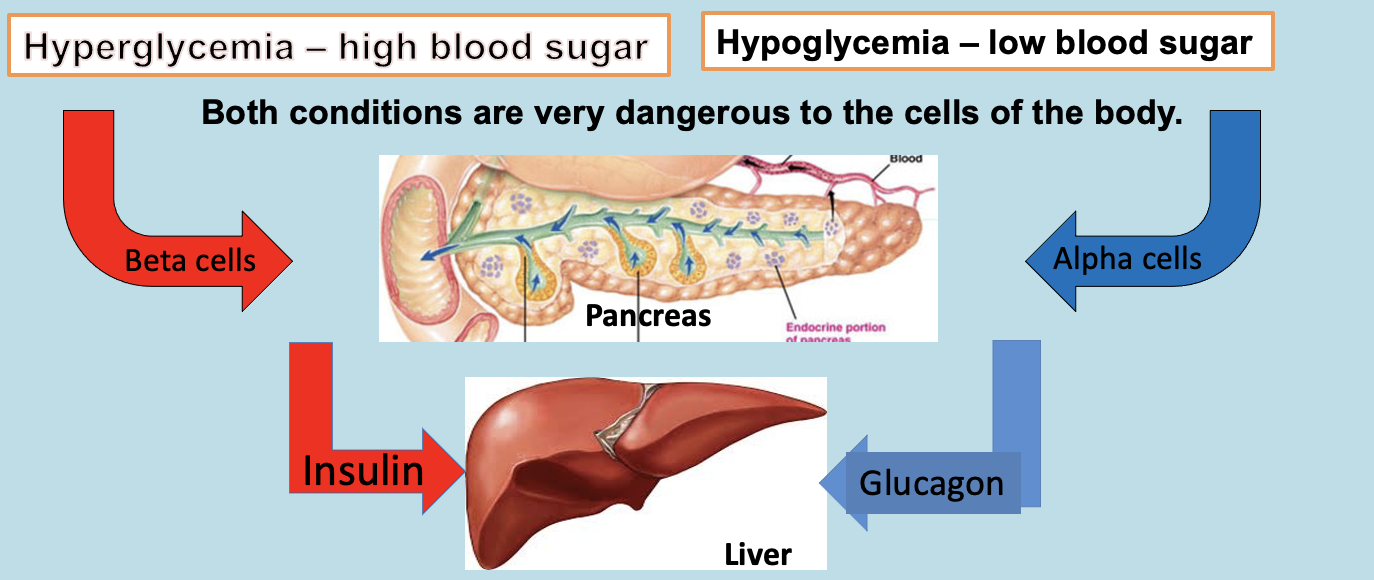
85
New cards
Insulin mediated Cellular glucose uptake.
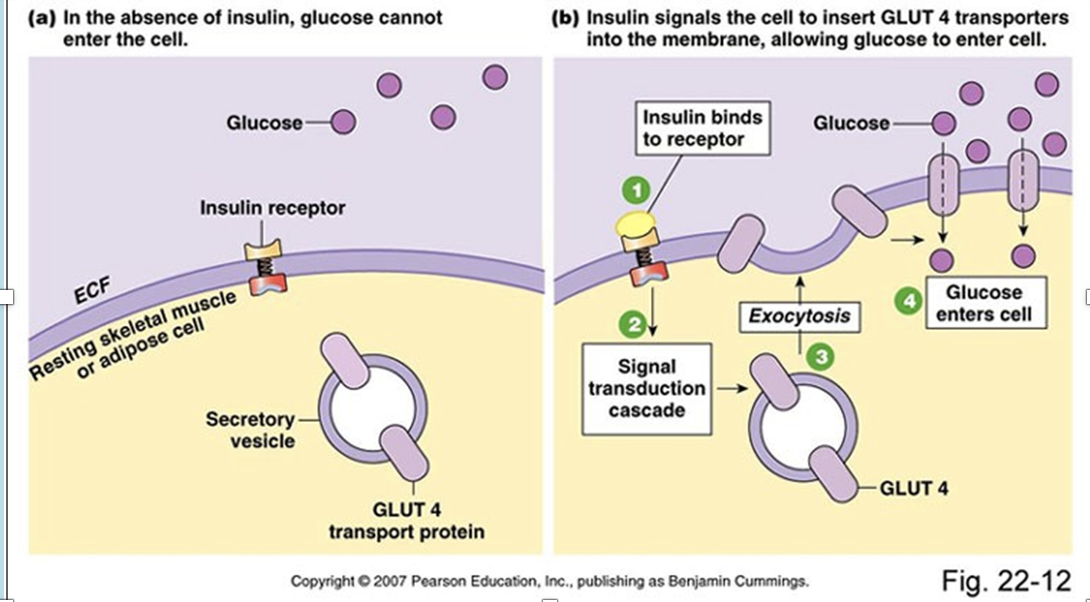
86
New cards
Glycolysis
glucose metabolism to produce energy
87
New cards
Glycogenesis Vs Glycogenolysis
formation of glycogen from sugar.
88
New cards
Gluconeogenesis
generation of glucose from non-carbohydrate
substrates
substrates
89
New cards
Diabetes
A disease in which the body’s ability to produce or respond to the hormone insulin is impaired, resulting in abnormal metabolism of carbohydrates and elevated levels of glucose in the blood and urine.
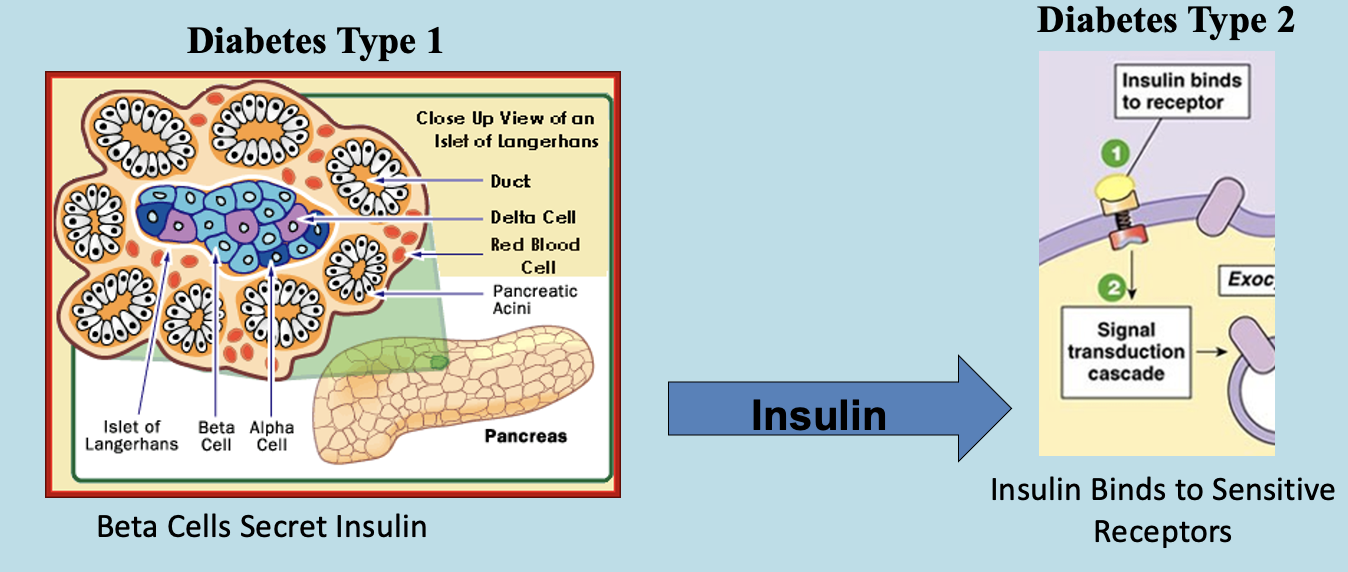
90
New cards
Essential Amino Acids
Phenylalanine
Valine
Tryptophan
Threonine
Isoleucine
Methionine
Histidine
Leucine
Lysine
Valine
Tryptophan
Threonine
Isoleucine
Methionine
Histidine
Leucine
Lysine
91
New cards
Water Soluble vs Fat Soluble Vitamins
Fat soluble vitamins; * Soluble in fats
- A, D, E, K
-They are Hydrophobic and lipophilic so they can be stored in liver fats and body fat depots.
- If consumed excessively, fat soluble vitamins accumulate in the body and can become toxic whereas excess water soluble vitamins are passed out in the urine !!!hint!!!.
Water soluble vitamins; * Soluble in Water
- B complex vitamins, C
- A, D, E, K
-They are Hydrophobic and lipophilic so they can be stored in liver fats and body fat depots.
- If consumed excessively, fat soluble vitamins accumulate in the body and can become toxic whereas excess water soluble vitamins are passed out in the urine !!!hint!!!.
Water soluble vitamins; * Soluble in Water
- B complex vitamins, C
92
New cards
Function of fats in the Animal/diet
1. Concentrated source of energy (supply energy – about 9.45 kcal/g vs. 4.2 kcal/g for carbohydrate (~2.25 x more energy)
2. Contribute to the Food palatability
3. Influence the texture of the diet and less dusty
4. The main source of Essential fatty acids (linoleic acid (C18:2) and linolenic acid (C18:3))
5. Carrier for fat-soluble vitamins (A, D, E, & K)
6. Affect the reproductive ability of the animal
7. Insulation and protection for the animal body
2. Contribute to the Food palatability
3. Influence the texture of the diet and less dusty
4. The main source of Essential fatty acids (linoleic acid (C18:2) and linolenic acid (C18:3))
5. Carrier for fat-soluble vitamins (A, D, E, & K)
6. Affect the reproductive ability of the animal
7. Insulation and protection for the animal body
93
New cards
Forms and sources of Fats
- Hard Fats are lipids that are of animal origin, e.g., tallow or lard (melting point >104o F or 40o C).
- Oils are lipids that are usually of plant origin, e.g. corn oil or soy bean oil, or from marine animals, Cod liver and fish oil.
- Oils are lipids that are usually of plant origin, e.g. corn oil or soy bean oil, or from marine animals, Cod liver and fish oil.
94
New cards
Classification of Lipids
1 - Simple Lipids
- Triglycerides; the major component of fats and oils, composed of
Fatty Acids attached together with Glycerol group.
- The major form of fat storage (fatty acid and chemical energy) in
Animal’s body.
2 - Complex Lipids
A- Phospholipids (fats complexed with a phosphoric acid group)
- Components of cell membranes important for firmness
- Nervous transmission
- Activation of many hormones.
B- Glycolipids; (Contain CHO) Components of cell membranes,
important for permeability.
C- Lipoproteins (Complexes of fat with protein)
- Cellular lipoproteins; important for cellular signaling.
- Plasma Lipoproteins; (Fat carrier in the blood), since fat is
hydrophobic (insoluble in water) proteins binds with triglycerides and
cholesterol to transport them in the blood between all the tissues of
the body.
- Since lipids have a lower density than water (oil floats on the
surface), the density of lipoproteins depends on the ratio of lipid to
protein.
- Lipoproteins are therefore classified according to their density
3- Miscellaneous Lipids
- Sterols – a completely different kind of fat, not based on fatty acids.
There are three 6 carbon rings and one 5 carbon ring.
- Most of these sterol compounds are only soluble in other fats and
oils. Common sterols include cholesterol, testosterone,
corticosterone, estradiol, progesterone, vitamin D, etc.
- Triglycerides; the major component of fats and oils, composed of
Fatty Acids attached together with Glycerol group.
- The major form of fat storage (fatty acid and chemical energy) in
Animal’s body.
2 - Complex Lipids
A- Phospholipids (fats complexed with a phosphoric acid group)
- Components of cell membranes important for firmness
- Nervous transmission
- Activation of many hormones.
B- Glycolipids; (Contain CHO) Components of cell membranes,
important for permeability.
C- Lipoproteins (Complexes of fat with protein)
- Cellular lipoproteins; important for cellular signaling.
- Plasma Lipoproteins; (Fat carrier in the blood), since fat is
hydrophobic (insoluble in water) proteins binds with triglycerides and
cholesterol to transport them in the blood between all the tissues of
the body.
- Since lipids have a lower density than water (oil floats on the
surface), the density of lipoproteins depends on the ratio of lipid to
protein.
- Lipoproteins are therefore classified according to their density
3- Miscellaneous Lipids
- Sterols – a completely different kind of fat, not based on fatty acids.
There are three 6 carbon rings and one 5 carbon ring.
- Most of these sterol compounds are only soluble in other fats and
oils. Common sterols include cholesterol, testosterone,
corticosterone, estradiol, progesterone, vitamin D, etc.
95
New cards
Fatty Acids
- Saturated Fatty acids
(No double bonds = between carbon atoms)
- Palmitic Acid (16C:0=)
- Stearic Acid (18C:0=)
- Unsaturated ( Double bond = present)
- MUFA (Mono-Unsaturated FA; 1 =),
- Oleic acid (high in olive oil)
- PUFA (Poly-Unsaturated FA; >1=)
- Linoleic Acid, Omega=6
- Linolenic Acid, Omega=3
- Arachidonic Acid 20c:
(No double bonds = between carbon atoms)
- Palmitic Acid (16C:0=)
- Stearic Acid (18C:0=)
- Unsaturated ( Double bond = present)
- MUFA (Mono-Unsaturated FA; 1 =),
- Oleic acid (high in olive oil)
- PUFA (Poly-Unsaturated FA; >1=)
- Linoleic Acid, Omega=6
- Linolenic Acid, Omega=3
- Arachidonic Acid 20c:
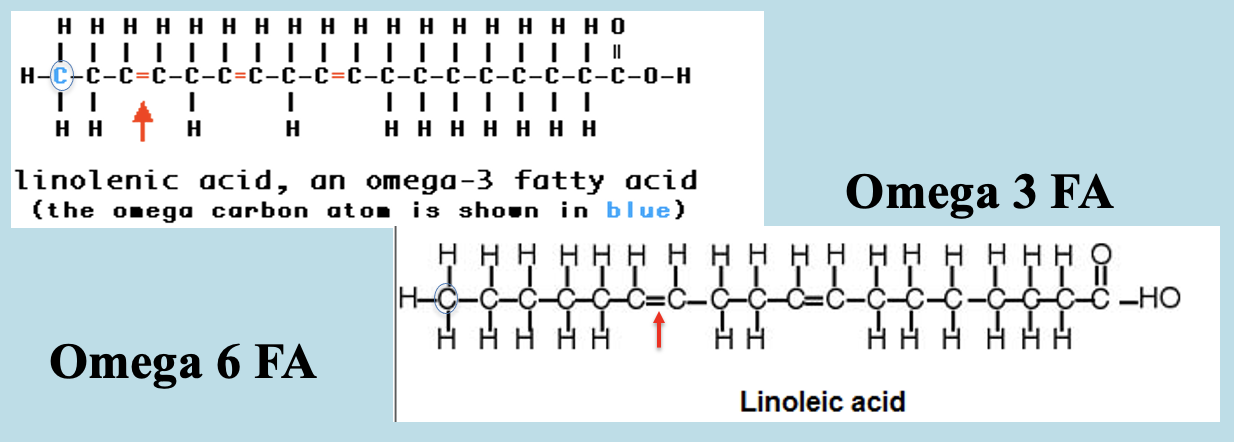
96
New cards
Macrominerals vs Microminerals
Macrominerals: needed at > 0.01% of body weight.
1. Calcium
2. Phosphorus
3. Potassium
4. Magnesium
5. Sodium
6. Chloride.
Microminerals: needed at
1. Calcium
2. Phosphorus
3. Potassium
4. Magnesium
5. Sodium
6. Chloride.
Microminerals: needed at
97
New cards
Essential fatty acids
1. Linoleic (an omega-6 FA)
2. Linolenic (an omega-3 FA)
3. Arachidonic
- In most species, but not cats (Cats must have all 3 provided in their diet), some birds and fish, arachidonic acid may be synthesized from linoleic acid.
- Present in Vegetable oils, particularly soybean, corn and safflower are good sources.
2. Linolenic (an omega-3 FA)
3. Arachidonic
- In most species, but not cats (Cats must have all 3 provided in their diet), some birds and fish, arachidonic acid may be synthesized from linoleic acid.
- Present in Vegetable oils, particularly soybean, corn and safflower are good sources.
98
New cards
Importance of (FATS) Essential fatty acids
1- They are a major constituent of the Cholesterol (sterol group) used for;
- Building Vitamin D (2, 25 dihydroxycholecalciferol)
- Building Steroid hormones (Corticosterone, aldosterone and cortisol
from the adrenal gland, estrogen and testosterone from gonads).
- Formation of Bile salt which responsible for fat digestion
2- Responsible for firmness (Phospholipid layer) and permeability (of the cell membrane.
3- Arachidonic acid is precursors to prostaglandins, very important element for inflammation and infection control and have a major role in reproduction.
- Building Vitamin D (2, 25 dihydroxycholecalciferol)
- Building Steroid hormones (Corticosterone, aldosterone and cortisol
from the adrenal gland, estrogen and testosterone from gonads).
- Formation of Bile salt which responsible for fat digestion
2- Responsible for firmness (Phospholipid layer) and permeability (of the cell membrane.
3- Arachidonic acid is precursors to prostaglandins, very important element for inflammation and infection control and have a major role in reproduction.
99
New cards
HDL (High Density Lipoproteins; Good Cholesterol)
bind with cholesterol and tend to remove it from the circulation to be metabolized in the liver or used for vitamin and hormones synthesis.
100
New cards
LDL (Low Density Lipoproteins; Bad Cholesterol)
bind with cholesterol and tend to accumulate in the blood circulation and blood vessels walls lead to several diseases, ex. Atherosclerosis (Thickening and narrowing of blood vessels).